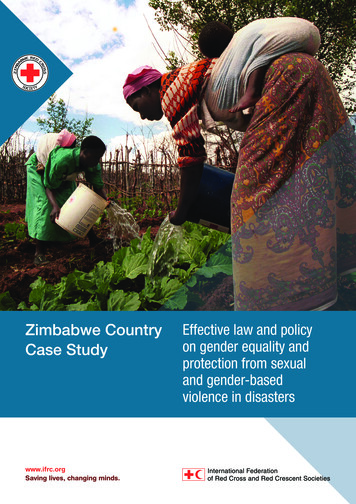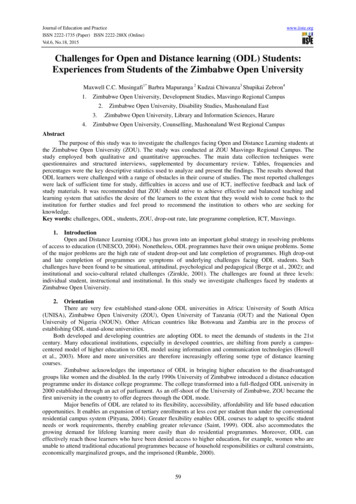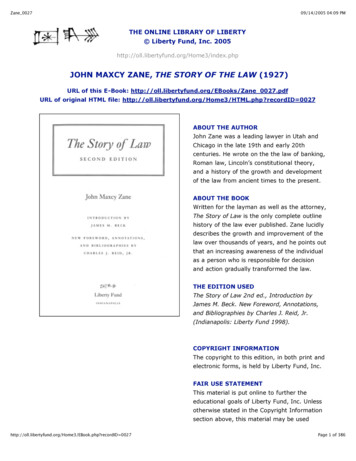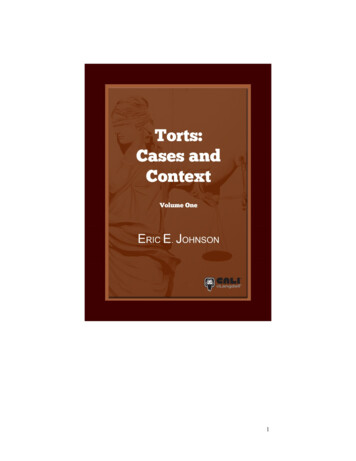
Transcription
Zimbabwe CountryCase StudyEffective law and policyon gender equality andprotection from sexualand gender-basedviolence in disasters
The International Federation of Red Cross and Red CrescentSocieties (IFRC) is the world’s largest volunteer-basedhumanitarian network. Together with our 189 member NationalRed Cross and Red Crescent Societies worldwide, we reach97 million people annually through long-term services anddevelopment programmes as well as 85 million people throughdisaster response and early recovery programmes. We act before,during and after disasters and health emergencies to meet theneeds and improve the lives of vulnerable people. We do so withimpartiality as to nationality, race, gender, religious beliefs, classand political opinions.Guided by Strategy 2020 – our collective plan of action to tacklethe major humanitarian and development challenges of thisdecade – we are committed to ‘saving lives and changing minds’.Our strength lies in our volunteer network, our communitybased expertise and our independence and neutrality. We workto improve humanitarian standards, as partners in developmentand in response to disasters. We persuade decision-makers to actat all times in the interests of vulnerable people.The result: we enable healthy and safe communities, reducevulnerabilities, strengthen resilience and foster a culture of peacearound the world. International Federation of Red Crossand Red Crescent Societies, Geneva, 2017Copies of all or part of this study may be made for noncommercialuse, providing the source is acknowledged The IFRC would appreciatereceiving details of its use. Requests for commercial reproductionshould be directed to the IFRC at secretariat@ifrc.org.The opinions and recommendations expressed in this study do notnecessarily represent the official policy of the IFRC or of individualNational Red Cross or Red Crescent Societies.P.O. Box 303CH-1211 Geneva 19SwitzerlandTelephone: 41 22 730 4222Telefax: 41 22 733 0395E-mail: secretariat@ifrc.orgWeb site: www.ifrc.org
Zimbabwe CountryCase StudyEffective law and policy on gender equality and protectionfrom sexual and gender-based violence in disastersZimbabwe Country Effective law and policyon gender equality andCase Studyprotection from sexualand gender-basedviolence in disasters1
2International Federation of Red Cross and Red Crescent SocietiesTable of ContentsAcknowledgements4Acronyms5Executive Summary6Part 1Introduction and Background1.1 Introduction99Terminology10Methodology10Zimbabwe Red Cross Society Initiatives121.2 Country Background12Disaster Risk In Zimbabwe12Incidence of Sexual and Gender-Based Violence In Zimbabwe12Part 2Law and Policy Frameworks on Gender and SGBV152.1 International and regional frameworks152.2 Zimbabwe’s constitutional provisions152.3 National law and policy on SGBV and gender equality17Part 3Implementation of the SGBV protection laws203.1 Awareness and promulgation213.2 Access to justice21Role of police22Legal aid22Family and community normalisation of SGBV22Child marriage233.3 Contribution of the laws to prevention and response to SGBV23Part 4Legal framework for disaster management (civil protection)25Part 5Implementation of the Civil Protection law27
Zimbabwe CountryCase StudyEffective law and policy on gender equality and protectionfrom sexual and gender-based violence in disastersPart 6Findings and recommendations286.1 Gender and SGBV legislation challenges286.2 Disaster management challenges296.3 Good practices for operational integration306.4 Recommendations31References33List of organizations and focus group communities interviewed353
4International Federation of Red Cross and Red Crescent SocietiesAcknowledgmentsThis country case study report was undertaken by Florence Mangwende,IFRC Consultant, with technical advice and editing support from Mary Picard,Lucia Cipullo, Isabelle Granger, Kaisa Laitila, Tina Tinde, Amjad Saleem andDavid Fisher from the IFRC.The IFRC wishes to thank the Zimbabwe Red Cross Society for its partnershipin the case study and especially for hosting the community visit, in particularMaxwell Phiri, Secretary-General, and Ernest Maruza, gender and diversityfocal point.The project partners wish to thank all those who participated in interviewsand focus group discussions in Zimbabwe, as their input was invaluable inunderstanding implementation of the legal and policy frameworks, and inproviding insights into the nature of sexual and gender-based violence as itoccurs in Zimbabwe, both in normal times and in disaster contexts.This research was made possible with support from the Swedish Red Cross,to which the IFRC expresses its gratitude.
Zimbabwe CountryCase StudyEffective law and policy on gender equality and protectionfrom sexual and gender-based violence in disastersAcronymsCEDAWCommittee on the Elimination of All Forms of DiscriminationAgainst WomenCEDAWConvention on the Elimination of All Forms of DiscriminationAgainst WomenCOMESACommon Market for Eastern & Southern AfricaCPRAChild Protection Rapid Assessment (CPRA)CSOCivil Society OrganisationDCPDepartment of Civil ProtectionDMDisaster ManagementDRMDisaster Risk ManagementDVADomestic Violence ActGBVGender Based ViolenceGBVNCGGBV National Coordination Group, under HRP ProtectionSectorGWENGirls and Women Empowerment NetworkHIVHuman Immunodeficiency VirusHRPHumanitarian Response Plan (HRP Protection Sector)IFRCInternational Federation of Red Cross and Red CrescentSocietiesIOMInternational Organization for MigrationNGONon-Governmental OrganizationsSADCSouthern African Development CommunitySGBVSexual and Gender-Based ViolenceUNFPAUnited Nations Population FundVFUVictim Friendly Unit (of Police)ZRCSZimbabwe Red Cross SocietyZWLAZimbabwe Women Lawyers’ Association5
6International Federation of Red Cross and Red Crescent SocietiesExecutive SummaryThis report outlines the results of a country case study undertaken duringDecember 2016 in Zimbabwe. It is part of a global IFRC initiative on ‘Effectivelaw and policy for addressing gender in disaster risk management andsexual and gender-based violence in disasters’.The country case study was conducted in order to contribute to: Implementing Resolution 3 of the International Conference of the RedCross and Red Crescent on ‘Sexual and gender-based violence: Jointaction on prevention and response’ (32IC/15/3); and Filling a knowledge gap on gender equality in disaster risk managementlaws, polices and their implementation, that was identified in the IFRCand UNDP 2014 study, Effective Law and Regulation to Support Disaster RiskReduction: A Multi-Country Report.The case study was undertaken as a desk review of national laws, policiesand secondary resources, followed by interviews with key informants inHarare and focus group discussions with women in rural communitiesin the Muzarabani district of Zimbabwe, to address the issues aroundimplementation. This district, on the Zambezi river flood plain in northernZimbabwe, experiences both floods and drought, and at the time of thestudy was affected by a two-year drought.This was a pilot case study, the first of three country studies, and lessonslearned from this methodology were then used to adapt the terms ofreference for the companion case studies in Ecuador and Nepal.The case study looks at both gender equality and sexual and gender-basedviolence in times of disaster. The definition of SGBV used in the reportrecognises that SGBV mainly affects women and girls, but can also affectboys and men. However, it is also noted that the policy and public discourseon these issues in Zimbabwe is focused almost entirely on women’s equalityand prevention of violence against women.Although informants have indicated there is an increase in SGBV incidenceand complaints during disasters, there is no data available to quantifythe extent of this. In slow-onset disasters, such as the communityimpoverishment triggered by a two-year drought, it was also difficult tomake a distinction between SGBV issues related to the disaster (loss offamily income and livelihoods, insufficient food) or those related to broadercultural attitudes (toleration towards some types of SGBV).The report identifies two frameworks of law and policy that are relevantto gender equality in disaster risk management (DRM) and to addressingsexual and gender-based violence (SGBV) in disasters:
Zimbabwe CountryCase StudyEffective law and policy on gender equality and protectionfrom sexual and gender-based violence in disasters There is an extensive legal framework related to gender equality,criminalisation and prevention of violence against women in normaltimes (outside the context of disasters). This is also intended to operateduring disasters. The report focuses on the Domestic Violence Act,which creates offences and establishes a system for protection ordersand survivor support, and also on the Sexual Offences Act 2002, nowpart of the Criminal Law. Police Victim Friendly Units are also part ofthis framework. Consultations for the case study indicated that thereare social and economic barriers to sanctioning SGBV as unacceptable,and to women accessing support services and the justice system, evenoutside the disaster context. The institutional frameworks for SGBVprotection and legal aid are also under-resourced, and are additionallystressed by disasters and emergencies: and The Civil Protection Act essentially establishes an institutional structurefor disaster preparedness and response, but does not include or mandatepolicy content on priorities in disaster management, and is silent onquestions of gender and SGBV protection in disasters.There is currently no formal connection between the framework to dealwith SGBV in normal times, and the civil protection system that is engagedduring disasters. There are also no specific provisions for disaster-resilienceof SGBV support services, and no mechanism for coordination with the civilprotection system on SGBV during disasters.The report finds that, although there is a legal framework for SGBV support,during normal times and during disasters, implementation is a challengedue to (a) lack of institutional resources, (b) insufficient legal aid forSGBV survivors, and (c) community attitudes of tolerance towards SGBVwithin families that create social barriers to accessing support servicesand the justice system. The additional strain placed on this frameworkduring disasters magnifies the existing challenges, and there is no specificmechanism in place to ensure the framework is disaster-resilient.The report also notes two existing good practice structures with potentialfor improving coordination on gender equality and SGBV during disasters,both slow-onset and rapid-onset. These are the national Anti-DomesticViolence Council under the Domestic Violence Act, and the GBV NationalCoordination Group (GBVNCG) established under the humanitarian clustersystem in Zimbabwe.The report recommends that:1. The Government uses its legislative discretion under the DomesticViolence Act, to expand the membership of the Anti-Domestic ViolenceCouncil, to increase awareness of the need for family support servicesfor SGBV prevention and access to justice during disasters, includingslow-onset disasters triggered by drought. The DVA already specifies thatthe Council includes representation from the ZRP, Council of Chiefs, andMinistry of Justice, and makes provision for further representation fromchurches, CSOs engaged on the issue and any other body or organisation7
88International Federation of Red Cross and Red Crescent Societiesthe Minister considers relevant. If the Civil Protection Department, ZRCSand NGOs engaged in SGBV protection were to be invited to join thisCouncil, it could be a useful vehicle for them to support a focus on SGBVin disasters and emergencies;2. In the medium to long term, the Government includes in an eventualrevision of the Civil Protection Law, both an institutional mandateand provision for resources to address gender equality in disaster riskmanagement, including for participation of women and SGBV preventionand protection.3. In the short to medium term, the Government proceeds, throughadministrative and policy-making mechanisms, to improve coordinationon gender equality and SGBV protection within the disaster managementsystem by:a. Ensuring significant representation of women on all committees andcouncils within the disaster management system at national andlocal levels, moving progressively to at least 30% women (consistentwith the gender equality provisions in the 2013 Constitution, theNational Gender Policy and SADC regional targets of women ingovernance);b. Including in key advisory bodies within the disaster managementsystem, representation of the Gender Commission, the Women’sMinistry, ZRCS, relevant NGOs, and women’s legal organisations andexperts, to increase the focus and understanding on gender equalityand SGBV protection in disaster preparedness and response;c.Formalising the role of the Protection Cluster, and especially theGender Based Violence (GBV) National Coordination Group (Subcluster of the Humanitarian Response Planning (HRP) ProtectionSector Cluster), as a key forum for Government agencies – especiallythe ZRP Victim Friendly Unit - ZRCS and NGOs to participate activelywith UN Agencies in (i) preparedness for SGBV prevention andprotection during disasters, and (ii) coordination on SGBV duringdisaster response and recovery operations.4. Government agencies, including the Women’s Ministry, health andwelfare services, and the ZRP Victim Friendly Unit, along with ZRCS,NGOs and UN Agencies, make a higher priority of community awarenessraising and support services on SGBV during normal times, to create amore solid community base for SGBV prevention and protection duringdisasters and disaster recovery. This should also extend to buildingcapacity amongst traditional leaders and local police. Given the reportedwide tolerance of domestic violence and child marriage, and the increasein both during disasters, this strategy would help to address the culturalbarriers to accessing support and justice on SGBV, focusing on preventionthrough working with communities, especially in rural areas.
Zimbabwe CountryCase StudyEffective law and policy on gender equality and protectionfrom sexual and gender-based violence in disastersPart 1Introduction and Background1.1 IntroductionThis report outlines the results of research carried out during December2016 in Zimbabwe. The research was conducted in Harare and Muzarabanidistrict in northern Zimbabwe. This Country Case Study was conducted aspart of a global initiative on ‘Effective law and policy for addressing gender indisaster risk management and sexual and gender-based violence in disasters’. Itwas the pilot case study in a group of three country case studies on thenational legal and policy frameworks addressing gender equality in disasterrisk management and protection from sexual and gender-based violence(SGBV) in disasters, including their implementation. Lessons learned fromthis methodology were then used to adapt the terms of reference for thecompanion case studies in Ecuador and Nepal.The country case study was conducted in order to contribute to: Implementation of Resolution 3 of the International Conference ofthe Red Cross and Red Crescent on ‘Sexual and gender-based violence:Joint action on prevention and response’ (32IC/15/3), and to address thespecific issue of how sexual and gender-based violence is consideredwithin legal frameworks. Resolution 3 “encourages the InternationalFederation, in collaboration with National Societies and other relevantpartners, to continue its research and consultations with a view toformulating relevant recommendations to prevent and respond tosexual and gender-based violence in disasters and other emergencies”(OP 30); and Filling a knowledge gap on gender equality in disaster risk managementlaws, polices and their implementation that was identified in the IFRCand UNDP 2014 study, Effective Law and Regulation to Support Disaster RiskReduction: A Multi-Country Report.The country case study was intended to contribute to an increasedunderstanding of the landscape on the inclusion of gender, the participationof women, and the prevention and response to SGBV within law andpolicy related to disaster risk management, and its implementation. Thiswill support the Zimbabwe Red Cross Society (ZRCS) in its dialogue withrelevant authorities, and the IFRC in its global engagement and advocacy. Ithas also contributed to the findings of the global review. The ultimate goalof the research is to inform law, regulation, programming and operationalplanning on disaster risk management, to produce better outcomes forSGBV survivors, women, children and affected communities as a whole.9
10International Federation of Red Cross and Red Crescent SocietiesTerminologyThe term ‘sexual and gender-based violence’ as used in this report, reflectsthe terminology in the above 2015 resolution of the International Conferenceof the Red Cross and Red Crescent. While different actors employ variousdefinitions of the overlapping terms “sexual violence” and “gender-basedviolence,” the term SGBV is based on two working definitions of the Movementwhich, although not formally adopted, are reproduced here to explain howthe term SGBV is used in the report. SGBV combines:‘Sexual violence’: Acts of a sexual nature committed against any person byforce, threat of force or coercion. Coercion can be caused by circumstancessuch as fear of violence, duress, detention, psychological oppression orabuse of power. The force, threat of force or coercion can also be directedagainst another person. Sexual violence also comprises acts of a sexualnature committed by taking advantage of a coercive environment or aperson’s incapacity to give genuine consent. It furthermore includes acts ofa sexual nature a person is caused to engage in by force, threat of force orcoercion, against that person or another person, or by taking advantage ofa coercive environment or the person’s incapacity to give genuine consent.Sexual violence encompasses acts such as rape, sexual slavery, enforcedprostitution, forced pregnancy or enforced sterilization; and‘Gender-Based Violence’: An umbrella term for any harmful act thatresults in, or is likely to result in, physical, sexual or psychological harm orsuffering to a woman, man, girl or boy on the basis of their gender. Genderbased violence is a result of gender inequality and abuse of power. Genderbased violence includes but is not limited to sexual violence, domesticviolence, trafficking, forced or early marriage, forced prostitution and sexualexploitation and abuse.1MethodologyThe research addresses four main questions: What is the extent of law and policy frameworks for gender and SGBVprotection in normal times, and how disaster-resilient are these? To what degree are gender and SGBV issues incorporated in the nationaldisaster risk management laws and policies in Zimbabwe? How effective is implementation of these legal / policy provisions inpractice? How could the existing legal and policy frameworks in Zimbabwe and/or their implementation, be strengthened to better address gender(including participation of women) and prevention of and response tosexual and gender-based violence, in disasters?To answer these questions a qualitative research methodology was adopted.Thus, the research was based on a review of literature, analysis of existinglaws, policies and plans, a review of practitioner reports, and focus group1ICRC and IFRC. 2015. Sexual and gender-based violence: joint action on prevention and response, Background report. (Geneva, October 2015). P. 1 n. 1
Zimbabwe CountryCase StudyEffective law and policy on gender equality and protectionfrom sexual and gender-based violence in disastersdiscussions with women in disaster affected communities in Muzarabanidistrict, northern Zimbabwe.The desk review focused on the legislation that governs issues of sexualand gender-based violence within Zimbabwe as well as those that governdisaster management (the term used in national law and policy is ‘civilprotection’).The following are the principal national legislative and policy frameworksconsulted: Constitution – 2013 Constitution of Zimbabwe Gender equality and protection from sexual and gender based violence.The analysis focuses on the Domestic Violence Act (2007) and the SexualOffences Act 2002, now part of the Criminal Law (Codification andReform) Act of 2006. The review also looks at relevant national reportsand policies, including the National Gender Policy, and the ZimbabweDemographics Health Survey. Civil protection – Civil Protection Act (Chapter 10.06), National CivilProtection Plan, and Disaster Risk Management Bill.In addition, the desk review considered relevant international and Africanregional treaty and policy frameworks in which Zimbabwe participates.The researcher consulted key informants through structured interviews.These included: Zimbabwe Red Cross; government departments (Departmentof Social Welfare and Department of Civil Protection); three UN agencies(IOM, UNFPA and UN Women); and two local civil society organizations, theZimbabwe Women Lawyers Association, and Girls and Women EmpowermentNetwork (GWEN) Trust. These were identified by the consultant as the mainstakeholders to contact as a matter of priority, although it was not possibleto obtain interviews with all key stakeholder within the timeframe of thestudy. A list of those interviewed is annexed to the report.Two focus group discussions were held with a total number of 30 women,in Muzarabani district. Group 1 were women community leaders identifiedand invited by ZRCS from a number of villages in Dambakurima Ward(wards being the most local government area). Group 2 were local womenvolunteers in the ZRCS ‘Community Based Health and First Aid Programme’working throughout the Muzarabani District.The Muzarabani District, in northern Zimbabwe on the flood plain of theZambezi River, was chosen because it is an area frequently affected bynatural hazards, experiencing either seasonal floods or droughts mostyears. At the time the case study was undertaken the communities had beenexperiencing a severe drought for more than two years, resulting in foodinsecurity and loss of agriculture-based livelihoods.11
12International Federation of Red Cross and Red Crescent SocietiesZimbabwe Red Cross Society InitiativesThis project was a partnership between IFRC and Zimbabwe Red CrossSociety (ZRCS). ZRCS is a key disaster responder in Zimbabwe, workingas an auxiliary to Government in providing humanitarian relief duringemergencies, such as floods. ZRCS runs various programmes with partnernational societies from within the Red Cross and Red Crescent Movement,including drought-related food distribution, and more recently cash transfers,to relieve food insecurity in selected communities. From its strong base oflocal members and volunteers, ZRCS works extensively with communitiesto build their resilience, and to develop their capacities through initiativessuch as the ‘Community Based Health and First Aid Programme.’ It also hasa long-term programme of guardianship of AIDS orphans, enabling them tocontinue living in their communities, under the guardianship of responsibleadults appointed to safeguard their welfare until adulthood.In recent years, ZRCS has increased its focus on gender and diversity. Much ofthis effort is based around implementing the 2015 International Conferenceresolution on SGBV, and the IFRC ‘Minimum standard commitments togender and diversity in emergency programming’. It has a designated focalpoint on these issues and participated in IFRC regional conferences on SGBV,in Kenya, in both 2015 and 2016.1.2 Country BackgroundDisaster Risk in ZimbabweAccording to the National Contingency Plan, in recent years Zimbabwe hasexperienced an increase in hazardous events, including disease outbreaks,floods, droughts and storms. These hazards, which are of both natural andhuman-induced origins, often trigger food, nutrition and health insecurity,and environmental degradation. Infrastructure including roads, publicbuildings and homes are also damaged. On the micro level, this has resultedin more fragile and less resilient family units, while on the macro levelthere is the opportunity cost of diverting resources to respond to theseemergencies. Evidence continues to show that disasters are likely to increasein Zimbabwe, particularly those that are weather-related, due to climatechange, with a projected overall temperature increase, and more extremedry and wet periods, resulting in more droughts as well as more floods.2Incidence of Sexual and Gender-Based Violence inZimbabweIn Zimbabwe, the working definition of GBV (the term used in Governmentpolicy) is drawn from the General Recommendation Number 19 of theCommittee on the Elimination of All Forms of Discrimination AgainstWomen (CEDAW), which defines gender-based violence as “violence that isdirected against a woman because she is a woman or that affects womendisproportionately.” This includes any act or threat to inflict physical, sexualor psychological harm. This working definition, also reflected in the laws,2GoZ, 2012. Zimbabwe National Contingency Plan: December 2012-November 2013.
Zimbabwe CountryCase StudyEffective law and policy on gender equality and protectionfrom sexual and gender-based violence in disasterssubstantially equates ‘gender’ with sex, so the main focus is on violenceagainst women. This is narrower than the scope of SGBV as described by theRed Cross and Red Crescent Movement, which recognises more overtly that,while SGBV mainly affects women and girls, it can also include violenceagainst men and boys based on gender roles.3 By contrast, in Zimbabwe,“gender-based violence” is often used interchangeably with “sexual violence”and “violence against women”.4In Zimbabwe, SGBV arises from social, cultural and religious practices thatsubordinate women, and may also make it unacceptable for men or women,girls or boys, to step outside socially assigned gender roles (including peoplewho identify as lesbian, gay, bisexual, transsexual or intersex). It thrives incommunities where violence is acceptable as a form of conflict resolution. It isfacilitated by patriarchal (male controlled) social hierarchies, by acceptanceof violence as a mode of social interaction and political interface, and bysocioeconomic inequality and a breakdown in norms and social structures.5In Zimbabwe, SGBV is seen particularly in acts of domestic violence relatedto gender roles. Spousal abuse is the most common form of SGBV.6 As aresult of the patriarchal nature of Zimbabwean society, women are affectedmore by SGBV than men. Women face sexual violence, physical violence,emotional and psychological violence and also socio-economic violence intheir homes, as well as violence outside the home.Some of the contributing factors to SGBV in Zimbabwe include: societalnorms on sexual rights and manhood; commercialization of ‘lobola’ or brideprice; socialization processes that condone abuse; economic factors such aspoverty, exploitation, access to and control over resources (e.g. land); variancebetween the modern and traditional/religious concepts of love by men andwomen; harmful traditional practices (e.g. girl child pledging for purposes ofappeasing avenging spirits, forced marriage, child marriage, forced virginitytesting and forced wife-inheritance); infidelity and polygamy; and limitedparticipation of women in decision-making.7Despite the enactment of laws to protect women, SGBV remains high. TheZimbabwe Demographic Health Survey of 2015 indicates that more than1 in 3 women have experienced physical violence since the age of 15. Thepercentage of women who experienced violence was at 14.5% in 2015; atthe same time, there is an increase in the percentage of women who reporthaving experienced violence in their lifetime (from 29.9% in 2010 to 34.8%in 2015). The most commonly reported perpetrator is the current or formerhusband or partner. Also, it is notable that one in two women without aneducation has experienced spousal violence,8 which may also be related tochild marriage of girls before they finish school, a phenomenon that alsoreportedly increases during the economic stress caused by disasters. It345678See: 32nd International Conference of the Red Cross and Red Crescent. 2015. Sexual and gender-based violence: joint action on prevention and response(Resolution 3, Geneva, Switzerland, 8-10 December 2015): and ICRC and IFRC. 2015. Sexual and gender-based violence: joint action on prevention andresponse, Background report. (Geneva, October 2015).Based on interviews, and national laws and policies, including: GoZ, 2013. National Gender Policy, Harare: Domestic Violence Act 2007; and Gender BasedViolence Act 14, 2006.Human Rights Forum. 2011. Human Rights Bulletin Number 68 : Gender Based Violence In Zimbabwe.Ibid.GoZ. 2012. Zimbabwe National Gender Based Violence Strategy 2012-2015. Harare: Ministry of Women Affairs, Gender and Community Development.Zimbabwe Demographic and Health Survey 2015: Key Indicators. Rockville, Maryland, USA: Zimbabwe National Statistics Agency (ZIMSTAT) and ICFInternational.13
14International Federation of Red Cross and Red Crescent Societiesis also more common for women to have lower education levels in ruralcommunities, and as these are the areas most affected by floods anddroughts, these existing vulnerabilities to SGBV are likely compounded bydisasters.Some current strategies for addressing SGBV in Zimbabwe include improvingawareness of the laws, and discussing with communities the social normsthat may condone SGBV. Awareness campaigns face particular challengesin resource-poor rural areas where, for most women, there is little or noacce
Red Cross and Red Crescent Societies worldwide, we reach . This was a pilot case study, the first of three country studies, and lessons . protection and legal aid are also under-resourced, and are ad










